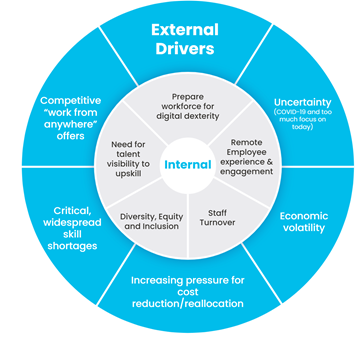
What is The Great Resignation?
As we emerge from the aftermath of the pandemic, new trends are starting to take shape in workforces across the world. In the UK, Europe and US, a record number of workers are leaving jobs – 4.5 million US workers resigned in November alone and Europe and the UK have experienced similar patterns. Employees between 30 and 45 years old have had the greatest increase in resignation rates, with an average increase of more than 20% between 2020 and 2021. And this trend is expected to continue in Australia. After years of record low employee turnover – this year Australia experienced the lowest employee turnover since 1972 – a survey found almost 40% of Australian workers want to find a new job in the next 12 months. Experts say the reality could be even higher.
As a result of COVID, we’ve been forced to change how we work so dramatically that businesses need to invest in their Employee Value Propositions more than ever to attract and retain competitive talent. From an HR perspective, now is the right time to be a relevant and strong voice on the leadership team. Every company needs total workforce visibility in order to maximise productivity and gain in a post-COVID world. As Josh Bersin mentions in his article, The Marriage of Talent Acquisition with Talent Mobility, “Why don’t you do this as part of your company’s strategic growth plan and focus on the skills, roles, and jobs you need to grow? Who knows this better than the head of Talent Acquisition? This person, if they’re positioned well in the company, sees the big picture of where the company is really going.”
What is Driving The Great Resignation?
The pandemic has caused a seismic shift in the global workforce, with organisations accelerating People Strategy initiatives that teams have been trying to get on the agenda for some time. These are:
Technology: We have seen the rapid ramp-up of digital enablement so that employees can work from home. This is something that has been pushed for a while, but it is now seen as essential.
Care: This is a make or break moment for organisations to show up and put wellbeing at the forefront. Some organisations have invested in wellbeing during this time, whereas others have reflected care through tone and messaging.
Mobility: We have seen an unprecedented movement of talent. A new language around essential work has been coined, as both a society and for organisations. We’ve moved talent with tough, but rapid decisions.
Flexibility: Employees are now going part-time because of external factors, such as child care. They are having conversations with leadership teams around reprioritisation of work in the hours available to them. This has busted norms and assumptions around “normal” working hours and shown us what is possible.
Technology, care, mobility and flexibility form the foundations of positive employee experience – businesses must address these factors to cater to the new remote workforce and ensure employees remain feeling engaged, valued and empowered. Without addressing these factors, businesses cannot hope to retain or attract talent in a competitive environment. Despite the many myths that working from home results in lower productivity, 85% of employees experienced higher burnout during COVID and nearly half reported having worse work/life balance due to overworking. There are many accounts of employees working longer hours, being accessible 24 hours a day and feeling pressure to take on more work. However, the solution to these problems is not as simple as just returning to the office. A recent Deloitte survey found 54% employees valued hybrid work as much as or more than a 5% pay rise.
The industries with the highest increases in staff turnover were those most impacted by the pandemic – 3.6% more Health Care employees quit their jobs than in the previous year, and in Tech, resignations increased by 4.5%. Another factor is simply the lack of opportunity to change jobs with ease over the past two years – so a backlog of resignations is likely to spring forward.
These statistics highlight the importance of measuring employee satisfaction and developing your Employee Value Proposition by prioritising candidate, and employee, experience.
How Can I Prepare for The Great Resignation?
There are steps every business can take to safeguard against a loss of talent and to proactively prepare for sourcing new candidates. It’s important to look at key market factors which influence recruitment and retention.
Key market factors can be divided into internal and external factors. External factors are more difficult to address and control – for example, international travel restrictions have affected the global workforce and will likely continue to do so for years to come. The key is to determine which external factors are likely to impact your business, and to then assess what internal factors can be measured and addressed in order to mitigate loss.

What all of these factors tell us is that candidate experience, proactive talent sourcing and staff retention are about to become more important than ever. Businesses must seek to adapt to the new labour market and consider key elements to avoid a potentially huge loss of talent.
Technology vendors are now building tools focused on internal workforce mobility, a critical enabler. Before, efforts were focused on acquisition, and there was a huge gap in internal mobility. Technology like LiveHire is now playing in the mobility space, leading the way for total talent. LiveHire partnered with TQ Solutions to leverage their Talent Maturity Diagnostic. This powerful diagnostic tool is designed to help organisations understand their relative maturity for Talent Acquisition as they plan their future strategy and roadmap, incorporating TQ’s next generation Maturity Model.
1. Identify At-Risk Positions
Data is one of the most powerful tools you have when analysing at-risk positions. Has your business previously experienced high turnover in particular roles or departments? Reviewing your hiring statistics from previous years can help to identify those roles which may be most at risk of turnover. HR teams should work with Hiring Managers to determine which key roles may be at risk in the organisation, then work on ways to either (1) retain at-risk staff, or (2) build Talent Pools for those roles so they are better-prepared to replace people after they leave.
Talent Pooling is an incredibly valuable resource when facing a hiring crisis. Talent Pooling involves the curation and nurturing of candidates who have expressed interest in your business who, after Talent Pooling and nurturing, you know you can connect with when a suitable position becomes available. Setting up Talent Pools is not difficult to do:
- Deploy an Applicant Tracking System which enables easy searching of a live database of candidates and invite them to join your Talent Pools.
- Utilise a CRM that gives you the ability to communicate with and nurture these candidates in order to understand when they are ready to be hired.
- Source talent proactively from multiple channels into your single platform of Talent Pools.
- Review your analytics regularly to understand which are your best sourcing channels.
Changes in the labour market highlight the importance of data and analytics, which can be difficult for businesses that do not employ the use of software solutions with robust analytics dashboards. Being able to quickly and easily access recruitment and employee data saves valuable time and money and can help inform your strategy moving forward. LiveHire’s recruitment analytics is a key feature that can help organisations drill down into their candidate and employee data to uncover trends and future-proof their workforce.
“With LiveHire, both our recruiters and hiring managers are collaborating on the same platform, which, paired with the use of the analytics functionality, means we’re able to make faster and better decisions.”
– Meredith Fay, GM HR Business Partnering and Operations, Vodafone
If your business utilises software that measures employee engagement and satisfaction, such as SAP SuccessFactors, this can be an extremely useful tool in helping to identify at-risk staff and look at what might be lacking in your business to keep employees engaged. For more on LiveHire’s integration with SAP SuccessFactors, see this blog.
2. Prioritise Candidate-Employee Experience
A study by PWC found half of job seekers say they’ve turned down an offer because of a bad candidate experience. The focus on candidate experience has become even stronger in recent years, with companies working to develop their employer brands in order to attract the best talent in a competitive market.
A key step in delivering great candidate experiences is to analyse your recruitment processes to identify and remove the barriers that lead to bad experiences. A poorly designed candidate experience can have a huge impact on your employer brand and includes things like:
- No communication or understanding of where people are in a job
- Delayed communication with recruitment teams
- Difficult to use platforms for candidates
- Tedious job applications
- No way to express interest in joining a company
You can then add features to your recruitment tech stack which address the missing elements to create great candidate experiences.
Modern recruitment platforms like LiveHire enable even slimmed-down hiring teams to remove negative experience barriers and deliver outstanding experiences. This is because modern recruitment SaaS platforms, like LiveHire, offer:
- A single view of talent and skills across the whole employee lifecycle
- Talent Pooling, which allows for the proactive recruitment of candidates ready for deployment when the right role becomes available
- The ability for candidates to create a single profile, with which they can express interest and apply for multiple jobs
- The opportunity to quickly and easily connect with candidates via 2-way SMS messaging
- An integration with your tech stack to enable rapid reference checks, video interviewing and more
- Advanced talent search capabilities to identify the right candidate for the right roles
- AI-powered intelligent job matching, and
- Empower existing staff to identify internal mobility opportunities
Candidate experience has a huge impact on your Employer Brand, which in turn affects your Employee Value Proposition (EVP). Having a great EVP is essential to attracting and retaining staff. A recent study found that almost one third of new starters leave a job within the first three months – and that the onboarding process can make or break the experience. Building a bridge between candidate experience and employee experience helps employees transition to new roles more quickly, and gives them a better sense of their position within the company.
3. Enable Internal Mobility
Internal mobility has become more difficult than ever in the age of COVID. Without the day-to-day visibility of the workplace, it can be tough for team leaders and HR managers to ensure internal staff are prioritised and their skills recognised. But this is essential for staff retention – 66% of workers said they would leave a role if they did not feel appreciated, and that number increased to 80% for millennial workers.
One of the biggest benefits of deploying recruitment and talent mobility software, such as LiveHire, is the opportunity for Total Talent Management. LiveHire allows a complete view of all of your external candidates, internal staff, contractors and alumni in one system – making it easy to identify internal mobility opportunities. This means you can:
- Leverage internal staff skills, rather than expensive external resources
- Build a pipeline of internal candidates before a hiring need arises
- Redeploy employees into new roles and avoid costly downsizing and outplacement
By looking at your existing employees when a new role comes up, and looking at your current structure to identify where employees may be eligible for promotion, you save valuable time and money whilst improving employee experience.
4. Utilise Talent Pools for Succession Planning
Talent Pools are without a doubt the best way to begin succession planning and to proactively source talent for your organisation. The beauty of Talent Pooling is that candidates don’t have to apply for a particular role with strict criteria – they can express interest in your business and share their skills and experience with you. You can then examine candidates’ profiles to determine which roles they may be best suited to when a role becomes available. LiveHire’s AI-powered job matching and intelligent search capabilities make it even easier to find, attract and retain quality candidates.
Talent Pooling is also extremely useful when sourcing high volumes of talent. For example, developing a Talent Pool for a role, such as a retail customer service position, without specifying location or hours, allows you to connect with a much broader range of candidates than simply posting to a job board. You can then pre-screen talent to determine which roles they may be suitable for, depending on factors such as location and hours. Bulk messaging capabilities offered by SaaS recruitment platforms are incredibly useful when communicating with your Talent Pools, as you can quickly and easily communicate with large volumes of candidates at once. This type of messaging also offers great mobility and flexibility to candidates, meaning communication response times are greatly reduced.
Conclusion
Although The Great Resignation presents businesses with many challenges, safeguarding your talent is possible with the right tools. If you’d like to find out more about how LiveHire can help your business retain staff and attract talent in this challenging time, request a meeting with our team today.



